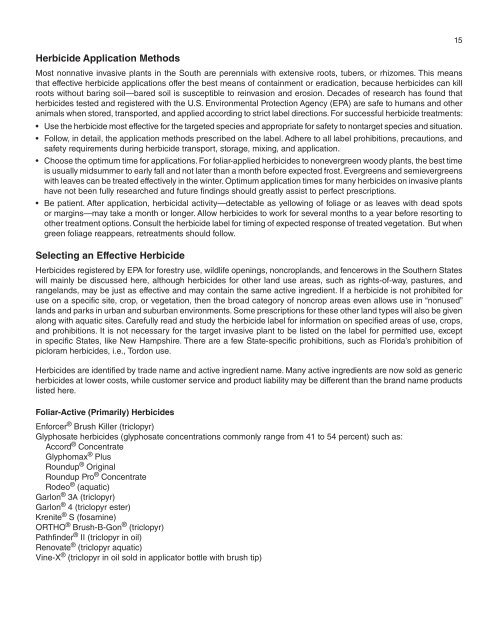A Management Guide for Invasive Plants in Southern Forests James ...
A Management Guide for Invasive Plants in Southern Forests James ...
A Management Guide for Invasive Plants in Southern Forests James ...
- No tags were found...
You also want an ePaper? Increase the reach of your titles
YUMPU automatically turns print PDFs into web optimized ePapers that Google loves.
Herbicide Application MethodsMost nonnative <strong>in</strong>vasive plants <strong>in</strong> the South are perennials with extensive roots, tubers, or rhizomes. This meansthat effective herbicide applications offer the best means of conta<strong>in</strong>ment or eradication, because herbicides can killroots without bar<strong>in</strong>g soil—bared soil is susceptible to re<strong>in</strong>vasion and erosion. Decades of research has found thatherbicides tested and registered with the U.S. Environmental Protection Agency (EPA) are safe to humans and otheranimals when stored, transported, and applied accord<strong>in</strong>g to strict label directions. For successful herbicide treatments:• Use the herbicide most effective <strong>for</strong> the targeted species and appropriate <strong>for</strong> safety to nontarget species and situation.• Follow, <strong>in</strong> detail, the application methods prescribed on the label. Adhere to all label prohibitions, precautions, andsafety requirements dur<strong>in</strong>g herbicide transport, storage, mix<strong>in</strong>g, and application.• Choose the optimum time <strong>for</strong> applications. For foliar-applied herbicides to nonevergreen woody plants, the best timeis usually midsummer to early fall and not later than a month be<strong>for</strong>e expected frost. Evergreens and semievergreenswith leaves can be treated effectively <strong>in</strong> the w<strong>in</strong>ter. Optimum application times <strong>for</strong> many herbicides on <strong>in</strong>vasive plantshave not been fully researched and future f<strong>in</strong>d<strong>in</strong>gs should greatly assist to perfect prescriptions.• Be patient. After application, herbicidal activity—detectable as yellow<strong>in</strong>g of foliage or as leaves with dead spotsor marg<strong>in</strong>s—may take a month or longer. Allow herbicides to work <strong>for</strong> several months to a year be<strong>for</strong>e resort<strong>in</strong>g toother treatment options. Consult the herbicide label <strong>for</strong> tim<strong>in</strong>g of expected response of treated vegetation. But whengreen foliage reappears, retreatments should follow.Select<strong>in</strong>g an Effective HerbicideHerbicides registered by EPA <strong>for</strong> <strong>for</strong>estry use, wildlife open<strong>in</strong>gs, noncroplands, and fencerows <strong>in</strong> the <strong>Southern</strong> Stateswill ma<strong>in</strong>ly be discussed here, although herbicides <strong>for</strong> other land use areas, such as rights-of-way, pastures, andrangelands, may be just as effective and may conta<strong>in</strong> the same active <strong>in</strong>gredient. If a herbicide is not prohibited <strong>for</strong>use on a specific site, crop, or vegetation, then the broad category of noncrop areas even allows use <strong>in</strong> “nonused”lands and parks <strong>in</strong> urban and suburban environments. Some prescriptions <strong>for</strong> these other land types will also be givenalong with aquatic sites. Carefully read and study the herbicide label <strong>for</strong> <strong>in</strong><strong>for</strong>mation on specified areas of use, crops,and prohibitions. It is not necessary <strong>for</strong> the target <strong>in</strong>vasive plant to be listed on the label <strong>for</strong> permitted use, except<strong>in</strong> specific States, like New Hampshire. There are a few State-specific prohibitions, such as Florida’s prohibition ofpicloram herbicides, i.e., Tordon use.Herbicides are identified by trade name and active <strong>in</strong>gredient name. Many active <strong>in</strong>gredients are now sold as genericherbicides at lower costs, while customer service and product liability may be different than the brand name productslisted here.Foliar-Active (Primarily) HerbicidesEn<strong>for</strong>cer ® Brush Killer (triclopyr)Glyphosate herbicides (glyphosate concentrations commonly range from 41 to 54 percent) such as:Accord ® ConcentrateGlyphomax ® PlusRoundup ® Orig<strong>in</strong>alRoundup Pro ® ConcentrateRodeo ® (aquatic)Garlon ® 3A (triclopyr)Garlon ® 4 (triclopyr ester)Krenite ® S (fosam<strong>in</strong>e)ORTHO ® Brush-B-Gon ® (triclopyr)Pathf<strong>in</strong>der ® II (triclopyr <strong>in</strong> oil)Renovate ® (triclopyr aquatic)V<strong>in</strong>e-X ® (triclopyr <strong>in</strong> oil sold <strong>in</strong> applicator bottle with brush tip)15
















